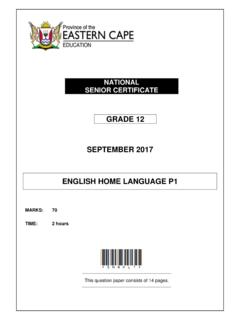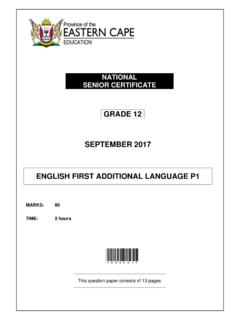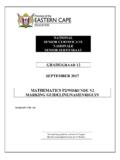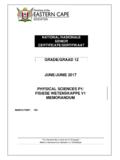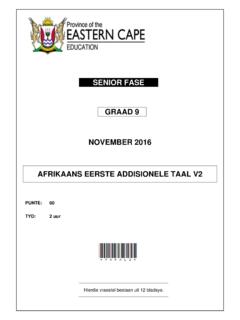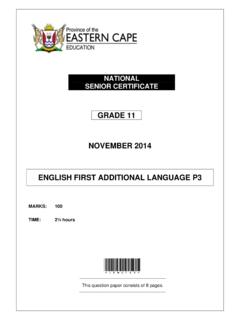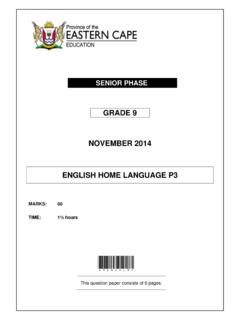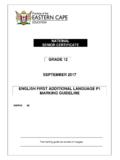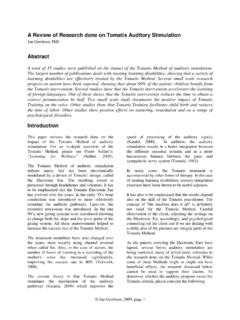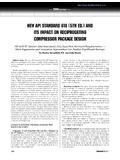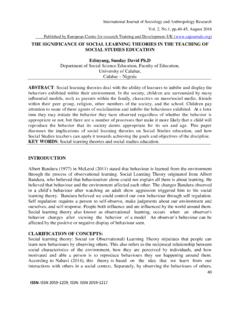Transcription of CONSUMER STUDIES (FOOD PRODUCTION) GUIDELINES …
1 Copyright reserved Please turn over CONSUMER STUDIES ( food production ) GUIDELINES FOR PRACTICAL ASSESSMENT TASKS 2012 INFORMATION FOR TEACHERS These GUIDELINES consist of 14 pages. CONSUMER STUDIES 2 DBE/PAT 2012 NSC ( food production ) Copyright reserved Please turn over THE PRACTICAL ASSESSMENT TASK FOR CONSUMER STUDIES food production 1. OVERVIEW During the Practical Assessment Task, the learner must demonstrate his/her knowledge and practical ability/skills to produce a variety of quality food products, focusing on suitability for selling. The Practical Assessment Task for Grade 12 consists of two practical examinations of 2 hours each. Learners perform these practical examinations individually.
2 O Term 2: Practical examination 1 Learners will make and present products selected for the micro-enterprise used for the project in term 1. o Term 3: Practical examination 2 Learners will produce a variety of food products suitable for selling, using a variety of skills and techniques. 2. MARK ALLOCATION Each exam consists of 100 marks. The mark for the final Practical Assessment Task is obtained by combining the marks for the 2 exams as indicated below. Practical examination: term 2 100 Practical examination: term 3 100 Total 200 2 Final mark for PAT 100 The marks for the PAT are part of the end-of-the-year assessment. The province will provide two separate computerised mark sheets, one for SBA and one for the PAT.
3 3. REQUIREMENTS FOR THE PRACTICAL EXAMINATIONS CONSUMER STUDIES is a choice subject with different practical options. This school has chosen to offer CONSUMER STUDIES as a subject, and selected the food production practical option. Therefore the equipment and funds necessary to conduct the PAT is the responsibility of the school, and are specified in circular S8 of 2006. Also specified is the ability of the school to ensure that practical lessons during the year take place. A suitable training kitchen with the necessary equipment: a minimum of 6 stoves (gas/electric), a refrigerator, electricity/gas, sinks with running water, and equipment and utensils for preparation and cooking. A minimum of R25 to a maximum of R40 per learner for EACH of the two practical examinations is required, over and above the funding required for the SBA practical lessons, to purchase ingredients to make the required products.
4 Divide learners into groups of a maximum of 12. Twenty-four learners (two groups of 12 learners) can do the exam on the same day ( from 08:00 11:00 and from 12:00 15:00). The teacher will need time between the two sessions to prepare the venue for the second group. Schools with large numbers of learners will need more than one day to complete this examination. CONSUMER STUDIES 3 DBE/PAT 2012 NSC ( food production ) Copyright reserved Please turn over 4. REQUIRED TIME FRAME A time frame of 2 hours, under examination conditions, (+ 45 minutes for teacher evaluation), is required for each exam total of 3 hours. 15 minutes for learners to draw their test and settle down at the workstation allocated to them and start collecting ingredients.
5 2 hours for preparation of the products. 45 minutes for the teacher to do evaluation, check the workstations of the learners and complete the mark sheets. 5. SETTING THE EXAMINATIONS Examination 1 (term 2) This practical examination must be slotted into the examination timetable in the second term. Learners will make the products they have chosen for their micro-enterprise (project in term 1). The saleability of the products forms an important aspect of this examination. Examination 2 (term 3) During the practical examination in the third term, learners must demonstrate a variety of culinary skills. They will be assessed on the production process and the saleability of the products. The teacher must set a minimum of 4 different tests.
6 Each test must: o Have at least two products o Have a minimum skill-code weighting of 20 points, including a variety of culinary skills and techniques o Include ONE of the following: - Yeast product (baked or deep fried) - Choux pastry - A gelatine dish (not jelly) - Swiss roll - Soft meringue such as lemon meringue pie or queen of bread pudding - Flour-based product such as biscuits, short crust pastry, muffins, scones/scone dough variation/pancakes/crumpets/waffles, other suitable flour-based products - Sugar cookery o The second product can include any appropriate skill or technique as long as the skill-code weighting adds up to a minimum of 20 points All recipes must.
7 O Be accompanied by a clear picture o Have clear instructions in short sentences and easy language o Be small, 2 4 portions o Be suitable for the available budget and other resources of the school o Be suitable for selling Prepare an order of work for each test. Prepare a memorandum with regard to the desirable qualities of each product for each test. The same four tests will be used for all the examination sessions, even if they take place on different days. CONSUMER STUDIES 4 DBE/PAT 2012 NSC ( food production ) Copyright reserved Please turn over The teacher must submit the following to the subject advisor for approval in the first week of term 2: o The tests and relevant recipes, indicating the weighting of the techniques according to the skill code o The order of work for each test o The memorandum with the desirable qualities for each product for each test o The planning for purchases o A draft budget and the estimate cost per learner o The checklist, signed by the principal o The proposed date for external on site moderation for the last group of learners.
8 This date should be negotiated with the subject advisor. o The signed checklist (attached) 6. PREPARING FOR THE EXAMINATION Set the dates. Communicate these dates to the SMT of the school, and make sure these dates do not clash with other school activities. It should be slotted into the timetable of the school for tests/exams. Have the stoves serviced and repaired. Photocopy the tests (recipes and work order) for the learners. Prepare mark sheets with learners' names and their examination numbers. Purchase the ingredients. Clean and tidy up the training kitchen. Put out the necessary equipment and ingredients. 7. PERFORMING THE EXAMINATION Learners will receive all four tests one week (7 days) before the date of the examination of the first group of learners.
9 When entering the examination room, each learner will draw ONE of the four tests. They will receive the recipes, order of work and desirable qualities/characteristics for the products of the test they have drawn, from the teacher. Learners will have 15 minutes to study the test and work schedule and collect ingredients. Learners performing the same test must be placed at different workstations, a learner performing test 1 could share a workstation and stove with a learner performing test 3. The products should be ready for assessment at the end of the 2 hours. After 5 minutes, learners will lose 2 marks for every 5 minutes late Only the teacher, the moderator and the candidates should be in the room during the practical examination.
10 The teacher must assess the learners while they are performing the practical examination. The teacher may not do any other work but should actively invigilate and assess each learner CONSUMER STUDIES 5 DBE/PAT 2012 NSC ( food production ) Copyright reserved Please turn over 8. EVALUATION The teacher and moderator have 45 minutes to evaluate the final products, inspect the workstations of the learners and complete the mark sheets. The learners should not leave before the evaluation and inspection are completed. They need to tidy up their workstations after completion of the examination, so that the teacher can inspect the workstations for the allocation of marks. 9. MODERATION OF THE PRACTICAL EXAMINATION During term 3, the last group of a maximum of 12 learners will be externally moderated by the relevant subject advisor while performing the practical exam at the school.

